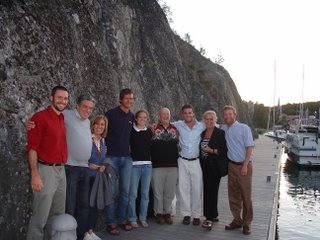June 16, 2006
Ship’s Log
June 16, 2006
Departure Location: Kastelholms Slott, Äland Islands
Departure Time: 14:00 hours
Distance Traveled.18.54
Arrival Location: Granskor, Äland Islands
Arrival Time: 17:30 hours
Weather: Wind out of the south, sunny and brisk
Personal Comments
We spent the morning walking up Orrdalsklint. Agreat view from the peak gave us a good perspective of the hundreds of small islands we have been sailing through these past few days. Also we found a small cabin dating back to WWII originally used as an observation post and now as a place for people to stay overnight when camping. We also got to blow up the dinghy tonight and spent some time rowing around the local coves. We caught yet another beautiful sunset lasting late into the night and good dinner of chili to hold us against the increasingly cold winds.
Research Comments:
Orrdalsklint, the site that Vinci proposes for Samothrace in the Baltic region is 423 feet high, one of the tallest points in the Äland islands. In the Iliad (1), Samothrace is the mountain from which Poseidon looks down on the battle between the Trojans and the Achaeans and realizes that the Achaeans are about to be beaten back to their ships. Upon making this realization he dons his armour and prepares to rally the Achaeans back into battle . Based on the topography of the islands and the evidence found in the Iliad, Vinci suggests that a shrine to Poseidon may have once stood atop this peak during the Early Bronze Age.
To further support his theory Vinci argues that the Baltic location of Samothrace is surrounded by islands containing references to the metal working culture (or Kabiric traditions) for which the area was supposedly famous. Lumparland, for instance, is cognate with English ‘lump’ and refers to masses of coal for heating a smith’s furnace, while the English ‘hammer’ is present in Hammerland and Hammarudda as well as in Hammerby just north of Täby, his candidate for Boeotian Thebes. Both islands are close to Lemland, Vinci’s candidate for Lemnos, island of both the lame archer hero Philoctetes and the lame smith god Hephaistos, who in Iliad 1.590-594 describes how he was lamed on the day Zeus grabbed him by the foot and tossed him out of Olympus, and how he fell all day until he landed on Lemnos. Vinci cites these lines as possibly a mythic account of the meteoritic origin of iron (p.160). There is evidence that the ancients lamed young boys to make them grow up with strong upper bodies and work as smiths, and it may well be that our words ‘lame’ and ‘limp’ are cognate with the ‘lem-‘ in both Lemland and Lemnos.
Like Freemasons, the Kabeiroi, members of the Kabiric metalworking cult, were guardians of mysteries they passed on only to initiates into their guild. Samothrace and Thebes, where their shrine the Kabirion was located, were two of their principal cult sites. In Mediterranean Greece this island of Samothrace is close to Troy but quite remote from Thebes in Boeotia, whereas the Täby near Stockholm, which Vinci identifies with Thebes, is not far at all from the Ordallsklint or Samothrace in Åland for which he argues (pp. 161-162). Yet again an anomaly in the current paradigm is resolved by his new hypothesis.
Iliad, 293-294, lines 1-43 in Fitzgerald’s translation.


0 Comments:
Post a Comment
<< Home